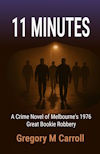21 April 1976 — Part I – The Crime of the Century
Chapter 1: The Arrival
Note 7: The robbery of the Victoria Club, home of the Australian Jockey Club (AJC), occurred just after midday on Wednesday, April 21, 1976. It was the first banking day after Easter, as Easter Tuesday was a bank holiday in Melbourne. Over the long weekend, there were five race meetings at four racecourses on the Saturday, Monday, and Tuesday. With banks closed until Wednesday, bookmakers loaded their Mayne Nickless bags. Enough to cover losses from Saturday. Enough to start again on Monday. Tuesday too, if needed.
Note 1: The Mayne Nickless armoured van delivering the bookies’ cash ran twenty minutes late that day. That morning, further up, Queen Street’s eastern side was being dug up. Southbound traffic jammed from end to end.
Note 2: The ground floor of the Victoria Club, at 131-141 Queen St, Melbourne, was high to cater for a mezzanine and the large height of the stained glass windows to Queen Street. This meant its second floor, which housed the Settling Room, was equivalent to the third floor of the neighbouring buildings.
Note 4: The building next door was under renovation at that time. A study of floor plans revealed an access door had been struck through the dividing wall during a previous renovation. It had subsequently been painted over on the Victoria Club side.
The crew
In the Melbourne underworld, a gang is called a crew. And the crew that carried out this robbery was a who’s who of Melbourne’s armed robbers.
Raymond “Chuck” Bennett, the General — the leader and mastermind.
Laurie Prendergast — a young, likeable larrikin and Bennett’s protégé.
Normie Lee, the Accountant — his family ran a dim sim and spring roll factory.
Ian “Fingers” Carroll — Bennett’s right-hand man and confidant.
Vinnie Mikkelsen — the hardest man in town, and Carroll’s long-time protector.
Tony McNamara — the weak link.
Yes, the culprits were known to the police. They just could not prove it. In fact, the Victorian Police Commissioner later referred to them as “the greatest team of armed robbers ever assembled.” They were all tied to the Painters and Dockers Union, which controlled Melbourne’s waterfront and most of its crime.
Note 3: Eight metal cash boxes were delivered by Mayne Nickless that morning. Each was 24 by 20 by 18 inches (600 x 500 x 450). They contained a total of 118 calico cash bags, each labelled with its bookie’s details.
Chapter 2: 11 Minutes
Note 5: Ambrose Harold Palmer (1910–1990) was a champion boxer, trainer, and VFL footballer. He won Australian titles in the middleweight, light-heavyweight, and heavyweight divisions and played 83 games for Footscray. Renowned for his intelligence and discipline, he trained world boxing champion Johnny Famechon and coached the 1956 Olympic boxing team. Awarded an MBE in 1971, he died on his 80th birthday in 1990, remembered as a Footscray local hero and doyen of Australian boxing.
Note 6: Such was the crew’s discipline, a bundle of $15,000 lying on one of the tables was left untouched.
Chapter 3: The Crime Scene
Note 8: Because of the high ground floor and mezzanine, there were eighty-six steps from the ground to the second floor.
Note 9: Police recovered high-powered weapons, including Thompson and Owen submachine guns, as well as an M16 automatic assault rifle. It is believed these were left behind because they were too hard to conceal when leaving the building and may have prompted police to search the rest of the building.
Note 10: At the crime scene, police recovered 118 cash bags, even though the bookies claimed only $1.387 million was stolen. That, they claimed, was the total takings for 116 bookies over all 5 race meetings that long weekend. The money deposited into the armoured van consisted mainly of high-denomination notes, $20 and $50 bills. A roll of $1,000 can easily fit in one hand. Based on the bookies' claim, this meant each calico bag contained only about $10,000, or ten rolls of cash, i.e. nearly empty. Exaggerated claims by journalists that the real amount stolen was $15 million were based on the assumption that each calico sack was full, i.e., containing $100,000. If that had been the case, each mail sack would have weighed approximately 50 kilograms, a weight even a young, fit wharfie would find hard to carry up two floors/four flights of stairs.
Note 11: In racing slang, a ‘monkey’ refers to a $500 bet, and a ‘gorilla’ to a $1,000 bet (a large monkey). Bookies paid turnover tax on the total amount wagered, regardless of whether the bets were won or lost. Operating two race bags with separate ticket sets was common practice.
Chapter 4: The Getaway
Note 12: The back stairs of the Victoria Club opened onto a rear laneway. From there, the crew made their way around the corner onto Queen Street. Witnesses questioned by police would not have seen anyone leaving either the Victoria Club or the neighbouring building.
